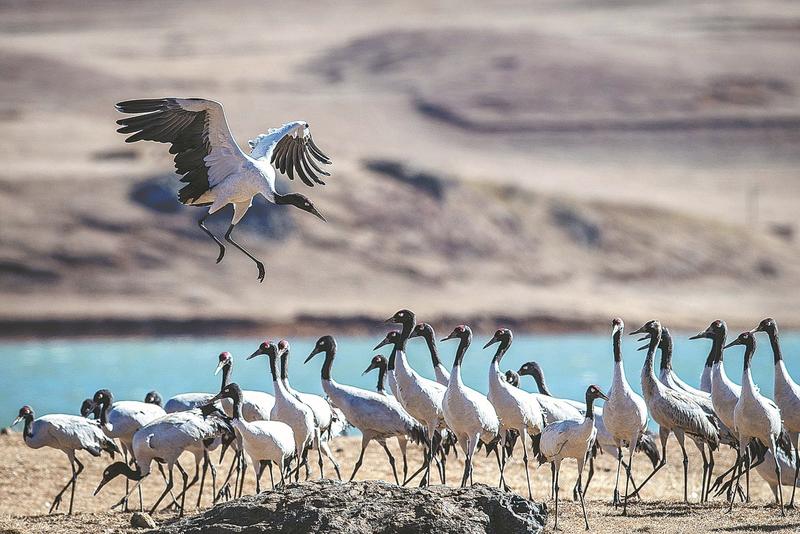 Black-necked cranes gather at the Dashanbao Black-necked Crane National Nature Reserve in Zhaotong, Yunnan province, Jan, 2022. (PHOTO / XINHUA)
Black-necked cranes gather at the Dashanbao Black-necked Crane National Nature Reserve in Zhaotong, Yunnan province, Jan, 2022. (PHOTO / XINHUA)
One black-necked crane, codenamed V021, has had quite the year.
Rescued near a national nature reserve in Yunnan province last spring, the young crane was injured and had been left behind when the rest of its flock migrated.
After a week in care, the bird was released by Wu Heqi, a researcher from the Chinese Academy of Sciences, after it was tagged to track its movements by satellite.
The tag was emblazoned with a "V", which Wu explained stood for "victory", and it was hoped the bird's release would lead to its successful return to the wild and onward migration.
In China, black-necked cranes migrate to their breeding grounds during the second half of March and then back to their wintering grounds between mid-October to November. They are listed as first-class protected animals and are the only crane species in the world to breed mainly on the Qinghai-Tibet Plateau.
The number of cranes has steadily increased in recent years thanks to conservation efforts. Guards, monitoring facilities and electronic fences help protect wintering grounds.
V021 was the first black-necked crane to be monitored by Wu's team using satellite tagging, a technology that allows researchers to accurately track a bird's altitude and speed, the ambient temperature and its flight route.
Since 2004, the team has tracked hundreds of birds-including 10 black-necked cranes since V021-using tags.
Wu said the data gathered shows that several national nature reserves in Guizhou and Yunnan provinces serve as stopovers along one of the migratory routes of the black-necked crane.
As for V021, it wintered in a nature reserve in Guizhou last year, arriving in November. Last month, it was tracked to a wetland in Sichuan province, an important summer destination for black-necked cranes.
Last year, it summered at another national nature reserve in northwestern Qinghai province. The Qinghai reserve on the Qinghai-Tibet Plateau is one of the main breeding grounds and habitats for black-necked cranes. Previously a resort, it was permanently closed to the public in April 2018 to protect its waterways and grasslands.
There has been a visible improvement to its environment in recent years, with lake water becoming clearer and vegetation recovering. The number of black-necked cranes breeding there has also increased.
This improving environment may also be the reason V021 chose to stay for over a month, said Zhang Tongzuo, a researcher at the Northwest Institute of Plateau Biology, a division of the CAS.
Reserve workers and researchers in China are exploring new ways to provide better protection to black-necked cranes. In recent years, Qinghai has promoted wildlife protection and the creation of nature reserves and wetlands, leading to greater biodiversity and to the province's growing population of cranes.



